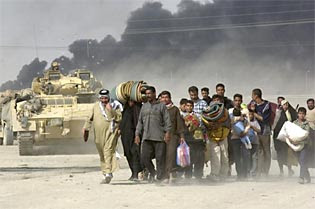Crowd farming
Need help paying your power bill, throw a party and invite a few thousand friends.
 No, we don’t recommend hitting your guests up for a donation but if 2 MIT grad students have their way, large venue events such as concerts and sporting matches may one day power their attractions with the aid of “Crowd Farming.”
No, we don’t recommend hitting your guests up for a donation but if 2 MIT grad students have their way, large venue events such as concerts and sporting matches may one day power their attractions with the aid of “Crowd Farming.”
Envisioned by James Graham and Thaddeus Jusczyk, both students at MIT’s School of Architecture and Planning, the “Crowd Farm” would turn the mechanical energy of people walking or jumping into a source of electricity. Their proposal took first place in the Japan-based Holcim Foundation's Sustainable Construction competition this year.
The technology used in for instance Boston's South Station railway terminal could be implemented by placing a responsive sub-flooring system made up of blocks that depress slightly under the force of human steps. The slippage of the blocks against one another as people walked would then generate power through the principle of the dynamo, a device that converts the energy of motion into that of an electric current.
The Crowd Farm is not intended for home use. According to Graham and Jusczy, a single human step can only power two 60W light bulbs for one flickering second. But get a crowd in motion, multiply that single step by 28,527 steps, for example, and the result is enough energy to power a moving train for one second.
The students' test case, displayed at the Venice Biennale and in a train station in Torino, Italy, was a prototype stool that exploits the passive act of sitting to generate power. The weight of the body on the seat causes a flywheel to spin, which powers a dynamo that, in turn, lights four LEDs.
"People tended to be delighted by sitting on the stool and would get up and down repeatedly," recalls Graham.
Other people have developed piezo-electric (mechanical-to-electrical) surfaces in the past, but the Crowd Farm has the potential to redefine urban space by adding a sense of fluidity and encouraging people to activate spaces with their movement.
"Our intention was to think of it not as a high-tech mat that would be laid down somewhere, but to really integrate it into a new sort of building system," Graham says.
The students were inspired in part by an "ingenious device invented by Thomas Edison. When visitors came to his house, they passed through a turnstile that pumped water into his holding tank," says Graham.
Greener Magazine
 No, we don’t recommend hitting your guests up for a donation but if 2 MIT grad students have their way, large venue events such as concerts and sporting matches may one day power their attractions with the aid of “Crowd Farming.”
No, we don’t recommend hitting your guests up for a donation but if 2 MIT grad students have their way, large venue events such as concerts and sporting matches may one day power their attractions with the aid of “Crowd Farming.”Envisioned by James Graham and Thaddeus Jusczyk, both students at MIT’s School of Architecture and Planning, the “Crowd Farm” would turn the mechanical energy of people walking or jumping into a source of electricity. Their proposal took first place in the Japan-based Holcim Foundation's Sustainable Construction competition this year.
The technology used in for instance Boston's South Station railway terminal could be implemented by placing a responsive sub-flooring system made up of blocks that depress slightly under the force of human steps. The slippage of the blocks against one another as people walked would then generate power through the principle of the dynamo, a device that converts the energy of motion into that of an electric current.
The Crowd Farm is not intended for home use. According to Graham and Jusczy, a single human step can only power two 60W light bulbs for one flickering second. But get a crowd in motion, multiply that single step by 28,527 steps, for example, and the result is enough energy to power a moving train for one second.
The students' test case, displayed at the Venice Biennale and in a train station in Torino, Italy, was a prototype stool that exploits the passive act of sitting to generate power. The weight of the body on the seat causes a flywheel to spin, which powers a dynamo that, in turn, lights four LEDs.
"People tended to be delighted by sitting on the stool and would get up and down repeatedly," recalls Graham.
Other people have developed piezo-electric (mechanical-to-electrical) surfaces in the past, but the Crowd Farm has the potential to redefine urban space by adding a sense of fluidity and encouraging people to activate spaces with their movement.
"Our intention was to think of it not as a high-tech mat that would be laid down somewhere, but to really integrate it into a new sort of building system," Graham says.
The students were inspired in part by an "ingenious device invented by Thomas Edison. When visitors came to his house, they passed through a turnstile that pumped water into his holding tank," says Graham.
Greener Magazine
Labels: Technology



1:00 PM




















